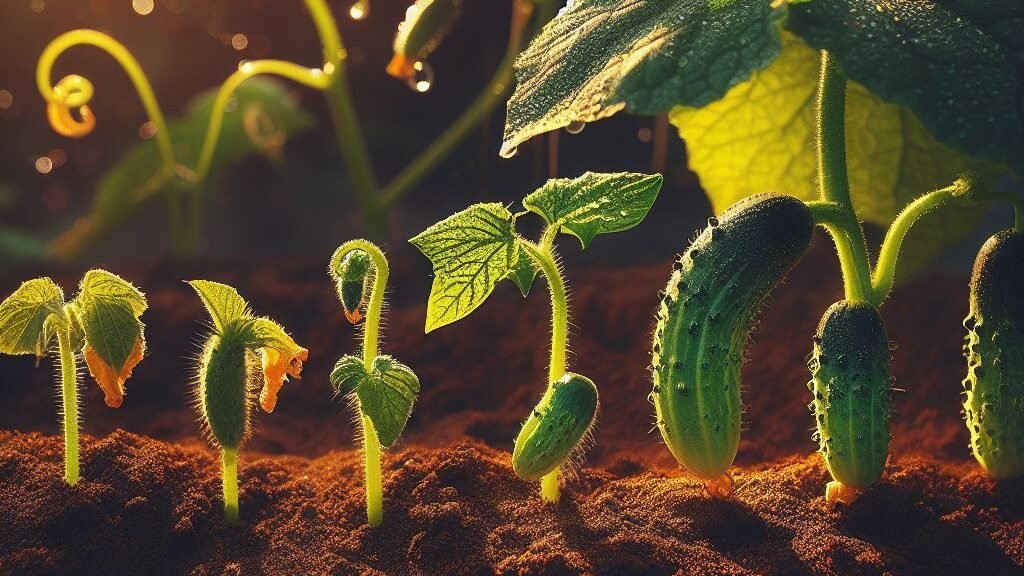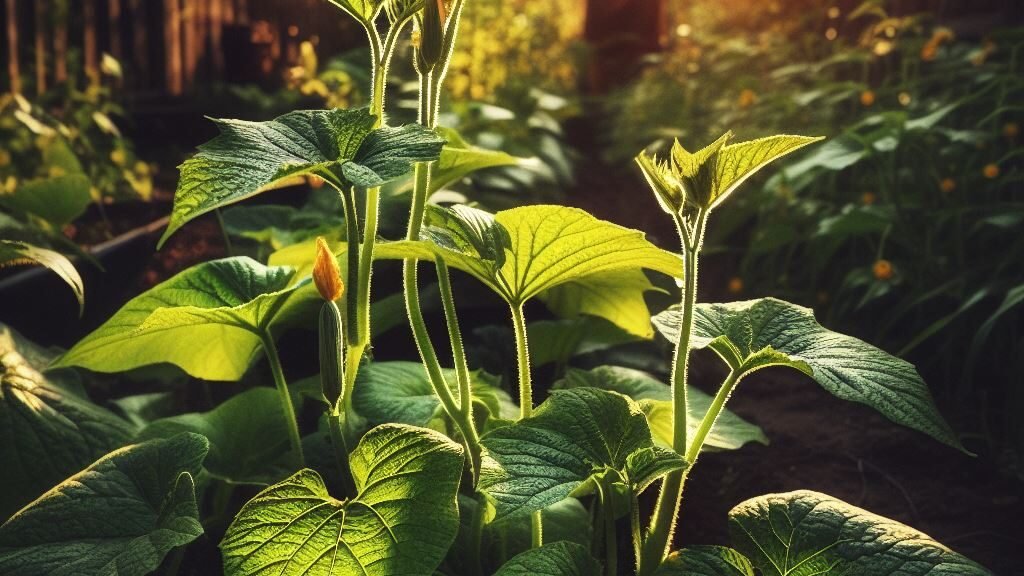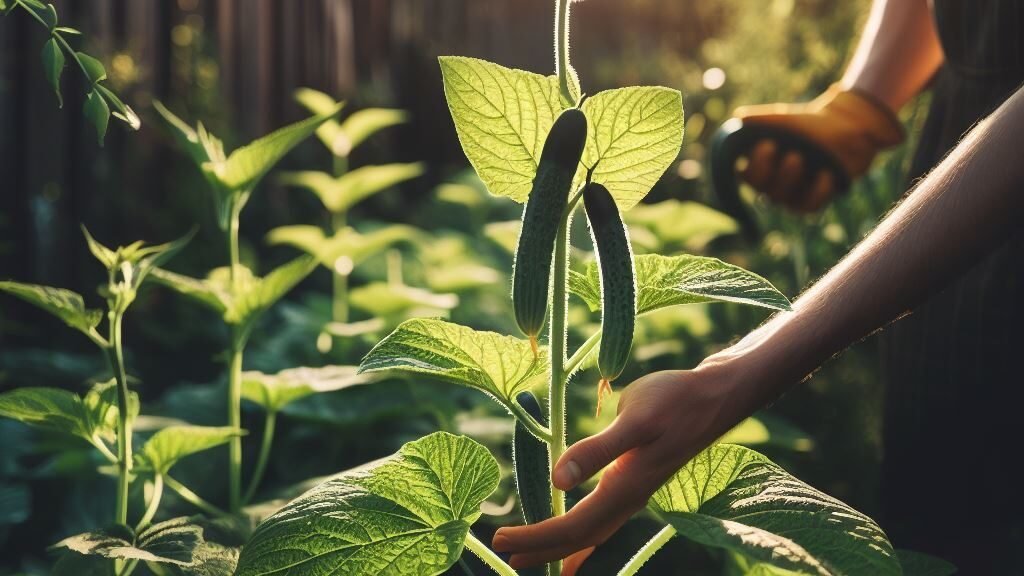Cucumbers are a refreshing and popular choice in green salads, sandwiches, and sides. But have you ever thought of growing cucumbers for yourself? If so, then read on! This comprehensive guide will walk you through each step of the Cucumber Plant Stages, from choosing the right plants to harvesting your cukes. You’ll learn about each stage of plant growth from planting and sprouting all the way to various diseases and techniques that produce the most delicious crops. With these tips in hand, soon enough you’ll have a bounty of tasty cucumbers at your fingertips – ready to be turned into something amazing!
Understand the Basics Cucumber Plant Stages

Different Types of Cucumbers
There are two primary types of cucumbers: slicing cucumbers and pickling cucumbers. Slicing cucumbers are generally larger and have a thick skin, making them ideal for consuming fresh. Pickling cucumbers, on the other hand, are smaller with thin skin, perfect for pickling.
Planting Requirements
Cucumbers require a good balance of sunlight and warmth to grow. They need at least 5 to 7 hours of full sun each day. The seeds should be planted in rows or “hills” with each plant spaced one to two feet apart.
Optimal Soil Conditions
Cucumbers prefer well-drained soil rich in organic matter. The pH level should ideally be between 6.0 and 7.0. To make the soil more favorable for cucumbers, consider adding some organic compost or a balanced general-purpose fertilizer before planting.
Planting Stage – What kind of seeds to buy, when and where to plant them

What Kind of Seeds to Buy
When choosing cucumber seeds, consider both the variety and the disease resistance of the seed. ‘Marketmore 76’ and ‘Straight Eight’ are popular choices for slicing cucumbers, while ‘Boston Pickling’ and ‘National Pickling’ are favorite varieties for pickling cucumbers. Look for seeds that are labeled as resistant to common cucumber diseases such as powdery mildew and cucumber mosaic virus.
When and Where to Plant Them
Cucumbers are warm-season crops and should be planted after the danger of frost has passed and the soil has warmed to at least 60°F (15°C). This typically happens in late spring or early summer, depending on your geographical location. As for where to plant them, choose a location that receives full sun for a minimum of 5-7 hours per day.
The site should also have good soil drainage. Plant the seeds about 1 inch deep, and if you are planting in rows, ensure each seed is spaced about a foot apart to allow room for growth.
Germination Stage – How long it takes for cucumber plants to sprout from seed
Cucumber seeds typically germinate within 3 to 10 days depending on the soil’s temperature. They sprout more quickly in warmer conditions, ideally between 70°F and 95°F (21°C to 35°C). However, they can still germinate in cooler soil, albeit at a slower pace.
It is crucial to keep the soil consistently moist, but not waterlogged, during this period. Once the seedlings break through the soil surface, they need plenty of sunlight in order to grow properly. Be patient and keep an eye on your planted area; with the right care and conditions, you’ll soon see the first signs of your future cucumber harvest.
Vegetative Growth Stage – Tips on caring for your cucumber plants during this stage
During the vegetative growth stage, proper care of your cucumber plants is vital for ensuring a bountiful harvest. Cucumber plants need ample water, especially during dry conditions. Aim to provide about an inch of water per week, either through rain or watering. Avoid watering the foliage, as this can lead to mildew or other diseases. Regularly check the plants for signs of pests or diseases such as yellowing leaves or stunted growth.

Fertilization is another key aspect during this stage. A side dressing of compost or a balanced fertilizer every 4-6 weeks can support healthy growth. To promote strong and healthy vines, consider providing a trellis or stake for your cucumbers to climb.
Finally, consider mulching around the base of your plants. Mulch helps to retain soil moisture and suppress weeds, providing a more conducive environment for your cucumbers to thrive. Remember to maintain the balance of care; overwatering or overfertilizing can be just as detrimental as under-providing these necessities.
Flowering Stage – How to identify male and female flowers
Cucumber plants produce both male and female flowers. Being able to identify them can be helpful, especially if you need to aid in pollination.

Male Flowers
Male flowers usually appear first on the plant, roughly a week before the female flowers. They are smaller and grow in clusters. You can identify male flowers by their thin, straight stalks and the absence of any fruit-like swelling beneath them.
Female Flowers
Female flowers, on the other hand, emerge singly and are larger than male flowers. The easiest way to identify a female flower is by spotting the small cucumber (ovary) behind the flower. This structure looks like a miniature cucumber and will develop into the actual fruit after pollination.
It’s important to note that both male and female flowers are crucial for cucumber production. Pollination requires the transfer of pollen from the male flower’s stamen to the female flower’s pistil. Sometimes, bees and other pollinators may not be as active in your garden. In such a case, you can manually pollinate the flowers using a small brush or cotton swab.
Fruiting Stage – Tips on harvesting cucumbers at the right time
Cucumbers should be harvested when they are at their peak of maturity. The ideal time to harvest depends on the type of cucumber and what you plan to use it for. Generally, slicing cucumbers should be harvested when they are about 6 to 8 inches long while pickling cucumbers should be picked when they are 2 to 4 inches long.
The cucumbers should feel firm and the skin should be bright medium to dark green depending on the variety. You should avoid letting cucumbers get too large or turning yellow as they tend to become bitter and seedy.

To harvest, use a sharp knife or pruning shears and cut the cucumber off the vine. Do not pull them as this can damage the vine. It’s recommended to harvest cucumbers early in the morning before the heat of the day to maintain their crispness. Harvesting regularly encourages the plant to produce more cucumbers.
Remember to handle harvested cucumbers with care to avoid bruising or damaging them. After harvesting, wash the cucumbers and store them in the refrigerator to maintain their freshness.
Common Pests and Diseases to Watch Out For – Prevention methods and solutions
Cucumber plants, like any other, are susceptible to various pests and diseases. Here are some common ones to watch out for, along with preventive methods and solutions:
Aphids
Aphids are small, soft-bodied insects that can cause significant damage to cucumber plants. They feed on the sap and can cause leaves to curl and yellow. Additionally, they can spread plant diseases. Prevention includes utilizing natural predators like ladybugs, or applying insecticidal soap. For serious infestations, consider using a specific aphid pesticide.
Cucumber Beetles
Cucumber beetles are a major pest for cucumber plants; they not only cause physical damage but can also transmit bacterial wilt. Prevention involves using row covers to protect the plants and crop rotation to break their life cycle. Infected plants should be removed to avoid spreading the disease.
Powdery Mildew
Powdery mildew is a fungal disease that results in a white powdery substance on the leaves. It can affect the yield and health of the plant. Prevention includes choosing resistant varieties, ensuring proper spacing for good air circulation, and applying fungicides if necessary.
Bacterial Wilt
Bacterial wilt is a disease that causes the plant to wilt and die rapidly. It’s transmitted by cucumber beetles and is usually fatal once it infects the plant. Prevention should focus on controlling the cucumber beetle population, as mentioned above.
Downy Mildew
Downy mildew is another fungal disease that affects cucumbers, resulting in yellowed leaves and stunted growth. Prevention includes using disease-resistant varieties, rotating crops, and using fungicides.
In conclusion, a combination of careful observation, good cultural practices, and timely intervention can help keep your cucumber plants healthy and productive.
Replanting Strategies – When and how to replant for an extended harvest season
For a continuous harvest throughout the season, replanting cucumber plants every few weeks is an excellent strategy. This method, known as succession planting, ensures that as older plants conclude their production, new ones are ready to take their place.
- Begin your first planting after the danger of frost has passed, with soil temperatures consistently over 60°F (15°C). Then, every two to three weeks, sow a new batch of cucumber seeds. This staggered planting schedule extends the harvest period, providing a steady supply of cucumbers throughout the summer and into early fall.
- However, be sure to cease new plantings at least 50-60 days before your area’s first predicted frost in autumn, to allow your final batch of cucumbers sufficient time to mature.
- When replanting, choose a new location within your garden each time, if possible. This practice, known as crop rotation, helps prevent pests and disease from becoming established in the soil, promoting healthier and more productive plants.
- At the same time, prepare the soil for each new planting as you did at the start of the season, by amending with compost or organic matter to ensure sufficient nutrients for your seedlings’ growth and development.
- Remember to keep a close eye on both your new and mature plants, tending to their watering, fertilization, and other needs as appropriate. By managing your plants carefully and thoughtfully, you can enjoy a plentiful cucumber harvest all season long.
Summary of Cucumber Life cycle
Here is an overview of the key factors to consider when growing cucumbers.
| Factor | Description |
|---|---|
| Variety | Choose a cucumber variety that’s suited to your climate and space constraints. Bush varieties are great for container gardening. |
| Soil | Cucumbers prefer well-drained, fertile soil. Amend with compost or organic matter to increase nutrient content. |
| Sunlight | Cucumbers require full sun, with a minimum of 6 hours of direct sunlight each day. |
| Watering | Water cucumbers deeply, providing at least one inch of water per week. Increase watering frequency during hot, dry periods. |
| Fertilization | Use a balanced vegetable or garden fertilizer to provide the essential nutrients. Compost or well-rotted manure can also improve soil fertility. |
| Pest Control | Use methods such as crop rotation, row covers, insecticidal soap, or specific pesticides to prevent and control pests. |
| Harvesting | Harvest size varies by cucumber type and personal preference, but generally, pickling cucumbers are harvested at 2-3 inches and slicing cucumbers at 7-8 inches. |
| Replanting | Plant new batches of cucumbers every 2-3 weeks for a continuous harvest. Stop planting 50-60 days before the first predicted frost. |
| Container/Climbing | For container gardening, choose bush types. For climbing varieties, provide a trellis or stake for support. |
| Indoor Growing | With the right conditions – ample sunlight or a suitable grow light, a consistent temperature range, and sufficient water and nutrients – cucumbers can also be grown indoors. |
Conclusion
In conclusion, growing cucumbers can be a rewarding experience, providing you with a bountiful harvest throughout the growing season. From selecting the right variety, understanding the growth stages, managing pests and diseases, to employing effective replanting strategies, every step plays a crucial role in ensuring a healthy and productive yield. Remember, patience and consistent care are vital, and with time, you’ll find yourself a master of the cucumber garden. Happy gardening!
Frequently Asked Questions (FAQs)
How often should I water my cucumber plants?
Watering depends on a variety of factors including the size of your plant, the weather, and the soil type. However, as a general rule, cucumber plants need at least one inch of water per week. In hotter weather, they may require more.
What is the best fertilizer for cucumbers?
Cucumbers require a high amount of nutrients, especially nitrogen. A balanced vegetable or garden fertilizer (like a 10-10-10) can work well. Applying a compost or well-rotted manure can also improve the soil fertility.
Why are my cucumber plants wilting or turning yellow?
Wilting or yellowing of cucumber plants can be a sign of many issues – overwatering, underwatering, a disease such as bacterial wilt, or a pest infestation. Accurate identification of the problem is key to resolving it.
Why are my cucumbers bitter?
Cucumbers can become bitter due to factors like irregular watering, high temperatures, or stress during growth. Ensuring regular watering, maintaining a balanced soil pH, and picking the cucumbers before they get too large can help prevent bitterness.
How to prevent cucumber beetles?
Prevention measures against cucumber beetles include using row covers to protect the plants and crop rotation. Additionally, insecticidal soap or specific pesticides can be used in case of a severe infestation.
Can I grow cucumbers in a pot or container?
Yes, cucumbers can be grown in pots or containers. Make sure to choose a container that is deep enough for the roots to grow, and a variety like ‘Bush Pickle’ or ‘Salad Bush’ that is suitable for container gardening.
How long does it take for a cucumber to grow?
From planting, cucumbers typically take 50 to 70 days to reach harvest. This can vary depending on the specific variety and growing conditions.
How much sun do cucumber plants need?
Cucumber plants thrive in full sun. They need a minimum of 6 hours of direct sunlight each day, but they will do best with 8 to 10 hours.
Can cucumbers grow indoors?
Yes, cucumbers can be grown indoors with the right conditions. They require ample sunlight or a suitable grow light, a consistent temperature range, and sufficient water and nutrients.
When is the best time to pick cucumbers?
The best time to pick cucumbers depends on the variety and your preference for size. Generally, pickling cucumbers should be harvested when they are 2 to 3 inches long, and slicing cucumbers when they are 7 to 8 inches long. It’s best to pick cucumbers early in the morning before the heat of the day sets in.
Why are the leaves on my cucumber plants turning yellow?
Yellowing leaves could be a sign of several issues such as nutrient deficiencies, overwatering, disease, or pest infestations. It’s crucial to correctly identify the cause in order to treat it effectively.
How do I save cucumber seeds for planting next year?
To save cucumber seeds, allow one of your cucumbers to mature on the vine until it is overripe. Then cut it open, scoop out the seeds, rinse them, and let them dry thoroughly before storing in a cool, dry place for the next year.





